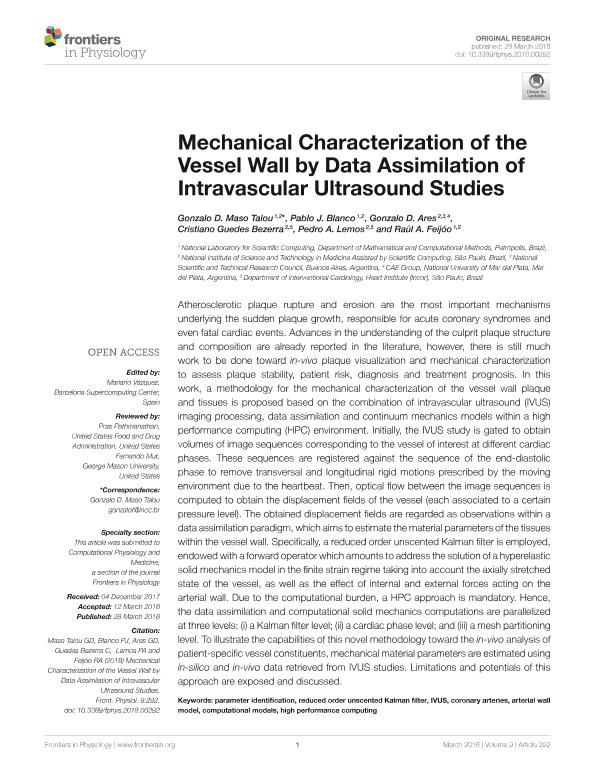Artículo
Mechanical Characterization of the Vessel Wall by Data Assimilation of Intravascular Ultrasound Studies
Maso Talou, Gonzalo Daniel; Blanco, Pablo Javier; Ares, Gonzalo Damián ; Guedes Bezerra, Cristiano; Lemos, Pedro A.; Feijóo, Raúl Antonino
; Guedes Bezerra, Cristiano; Lemos, Pedro A.; Feijóo, Raúl Antonino
 ; Guedes Bezerra, Cristiano; Lemos, Pedro A.; Feijóo, Raúl Antonino
; Guedes Bezerra, Cristiano; Lemos, Pedro A.; Feijóo, Raúl Antonino
Fecha de publicación:
03/2018
Editorial:
Frontiers Media S.A.
Revista:
Frontiers in Physiology
ISSN:
1664-042X
Idioma:
Inglés
Tipo de recurso:
Artículo publicado
Clasificación temática:
Resumen
Atherosclerotic plaque rupture and erosion are the most important mechanisms underlying the sudden plaque growth, responsible for acute coronary syndromes and even fatal cardiac events. Advances in the understanding of the culprit plaque structure and composition are already reported in the literature, however, there is still much work to be done toward in-vivo plaque visualization and mechanical characterization to assess plaque stability, patient risk, diagnosis and treatment prognosis. In this work, a methodology for the mechanical characterization of the vessel wall plaque and tissues is proposed based on the combination of intravascular ultrasound (IVUS) imaging processing, data assimilation and continuum mechanics models within a high performance computing (HPC) environment. Initially, the IVUS study is gated to obtain volumes of image sequences corresponding to the vessel of interest at different cardiac phases. These sequences are registered against the sequence of the end-diastolic phase to remove transversal and longitudinal rigid motions prescribed by the moving environment due to the heartbeat. Then, optical flow between the image sequences is computed to obtain the displacement fields of the vessel (each associated to a certain pressure level). The obtained displacement fields are regarded as observations within a data assimilation paradigm, which aims to estimate the material parameters of the tissues within the vessel wall. Specifically, a reduced order unscented Kalman filter is employed, endowed with a forward operator which amounts to address the solution of a hyperelastic solid mechanics model in the finite strain regime taking into account the axially stretched state of the vessel, as well as the effect of internal and external forces acting on the arterial wall. Due to the computational burden, a HPC approach is mandatory. Hence, the data assimilation and computational solid mechanics computations are parallelized at three levels: (i) a Kalman filter level; (ii) a cardiac phase level; and (iii) a mesh partitioning level. To illustrate the capabilities of this novel methodology toward the in-vivo analysis of patient-specific vessel constituents, mechanical material parameters are estimated using in-silico and in-vivo data retrieved from IVUS studies. Limitations and potentials of this approach are exposed and discussed.
Archivos asociados
Licencia
Identificadores
Colecciones
Articulos(CCT - MAR DEL PLATA)
Articulos de CTRO.CIENTIFICO TECNOL.CONICET - MAR DEL PLATA
Articulos de CTRO.CIENTIFICO TECNOL.CONICET - MAR DEL PLATA
Citación
Maso Talou, Gonzalo Daniel; Blanco, Pablo Javier; Ares, Gonzalo Damián; Guedes Bezerra, Cristiano; Lemos, Pedro A.; et al.; Mechanical Characterization of the Vessel Wall by Data Assimilation of Intravascular Ultrasound Studies; Frontiers Media S.A.; Frontiers in Physiology; 9; 3-2018; 1-25
Compartir
Altmétricas



